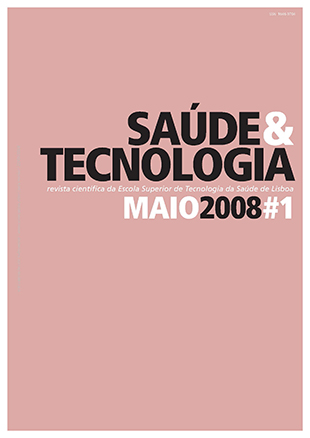Evaluation of the grip force, lower body strength and functional capacity in active and sedentary elders
DOI:
https://doi.org/10.25758/set.54Keywords:
Aging, Physical activity, Sedentarism, Functional capacity, Muscle strengthAbstract
Background - The practice of regular physical activity has a better impact on the global physical condition of elderly people. Purpose - The mentoring of this study is to analyze if the practice of regular physical activity has any influence on the grip force, lower body strength, and functional capacity of the inhabitants of the Loures district aged over 60. Methods - A questionnaire was applied to a selected sample of elderly persons, aged over 60, from the Loures district. A random sample of 60 inhabitants, aged between 60 and 91 were selected, out of which 30 practiced regular physical activity and the other 30 didn’t. The authors evaluated: the grip force using a portable dynamometer Biometrics E-Link, the lower body strength through the chair sit-to-stand test, the functional capacity through the six-minute walk test, and the perceived exertion through Borg´s scale. Results - We recorded that the regular practice of physical activity influences significantly: the Peak Force on the left grip (p=0,037) as well as on the right grip (p=0,022), the Endurance on the left grip (p=0,017), the number of correct performances realized in the chair sit-to‑stand test (p=0,00), the total distance performed in the six-minute walk test (p=0,00), and the perceived exertion mentioned in the six-minute walk test. Respectively to the values of Time to Peak on the left (p=0,630) and right (p=0,570) grip as well as the endurance on the right grip (p=0,219), there were no found significant differences between the two groups. Conclusion - The authors came to the conclusion that the practice of physical activity in this random sample contributed to a better physical condition which leads to a higher performance that fulfills body functions, body strength, and less physical fatigue.
Downloads
References
Berger L, Mailloux D. Pessoas idosas: uma abordagem global. Lusodidacta; 1995..
D.G.S. Programa Nacional para a Saúde das Pessoas Idosas. Lisboa: DGS; 2004.
WHO Keep fit for life: meeting the nutritional needs for older persons. WHO; 2002.
American College of Sports Medicine. Position stand on exercise and physical activity for older adults. Med Sci Sports Exerc. 1998;30:992–1008.
Cress M, et al. Best practices for physical activity programs and behavior counseling in older adult populations. J Aging Phys Act. 2005;13(1):61–74.
Adrian M, Cooper J. Biomechanics of human movement. Indianapolis: Benchmark; 1989.
Mazzeo R, et al. Exercise and Physical Activity for Older Adults. ACSM; 1998.
Matsudo S. Envelhecimento e Actividade Física. Londrina: Midiograf; 2001.
Fiatarone M, et al. High-intensity strength training in nonagenarians: effects on skeletal muscle. JAMA. 1990;263(18):3029–34.
Barata T, et al. Actividade Fisica e Medicina Moderna. Europress; 1997.
Craveiro I, Ferrinho P. Planear estrategicamente: a prática no SNS. Rev Port Saúde Pública. 2001;19(2):27–37.
Fortin M. O processo de investigação, da concepção à realização. Lusociência; 2000.
ATS statement: guidelines for the six-minute walk test. ATS Committee on Proficiency standards for clinical Pulmonary Function Laboratories. Am J Respir Crit Care Med. 2002;166(1):111–7.
Biometrics Operating manual E-Link, evaluation & exercise systems. Manual de utilização do Dinamómetro Computorizado Portátil Biometrics E-Link. 2004.
Jones, et al. The realiability and validity of a chair sitand-reach test as a measure of hamstring flexibility in older adults. Res Q Exercise Sport. 1998;69(4):338-43.
Weisman I, Zeballos R. Clinical exercise testing. Karger; 2002.
Enright P. The six-minute walk test. Respir Care. 2003;48(8):783–5.
Borg G. Escalas de Borg para a Dor e o Esforço Percebido. Manole; 2000.
Chaimowicz F. A saúde dos idosos brasileiros às vésperas do século XXI: problemas, projecções e alternativas. 1996. Disponível em: http://www.scielo.br/scielo. Acesso em: 25 de Abril de 2007.
McArdle W, Katch F, Katch V. Fisiologia do exercício: energia nutrição e desempenho humano. 5ª ed. Guanabara; 2003.
Seeley R, Stephens T, Tate P. Anatomia & Fisiologia. Lusodidacta; 1997.
Briffa K, Devereux K, Robertson D. Effects of a water-based program on women 65 years and over: a randomised controlled trial. Aust J Physiother. 2005;51:102–8.
Rikli, Jones. Development and validation of a functional fitness test for community residing older adults. J Aging Phys Act. 1999;7:129–61.
Downloads
Published
Issue
Section
License
Copyright (c) 2023 Saúde e Tecnologia

This work is licensed under a Creative Commons Attribution-NonCommercial-NoDerivatives 4.0 International License.
The journal Saúde & Tecnologia offers immediate free access to its content, following the principle that making scientific knowledge available to the public free of charge provides greater worldwide democratization of knowledge.
The journal Saúde & Tecnologia does not charge authors any submission or article processing charges (APC).
All content is licensed under a Creative Commons CC-BY-NC-ND license. Authors have the right to: reproduce their work in physical or digital form for personal, professional, or teaching use, but not for commercial use (including the sale of the right to access the article); deposit on their website, that of their institution or in a repository an exact copy in electronic format of the article published by Saúde & Tecnologia, provided that reference is made to its publication in Saúde & Tecnologia and its content (including symbols identifying the journal) is not altered; publish in a book of which they are authors or editors the total or partial content of the manuscript, provided that reference is made to its publication in Saúde & Tecnologia.







